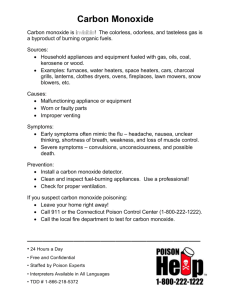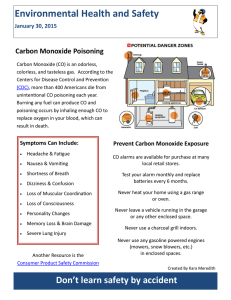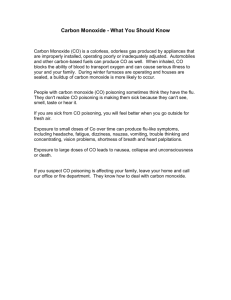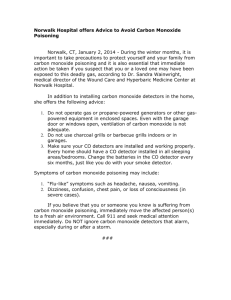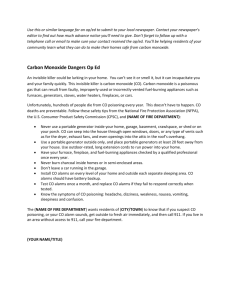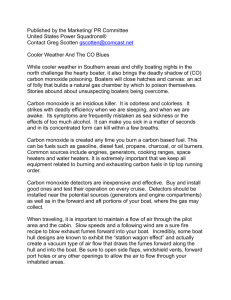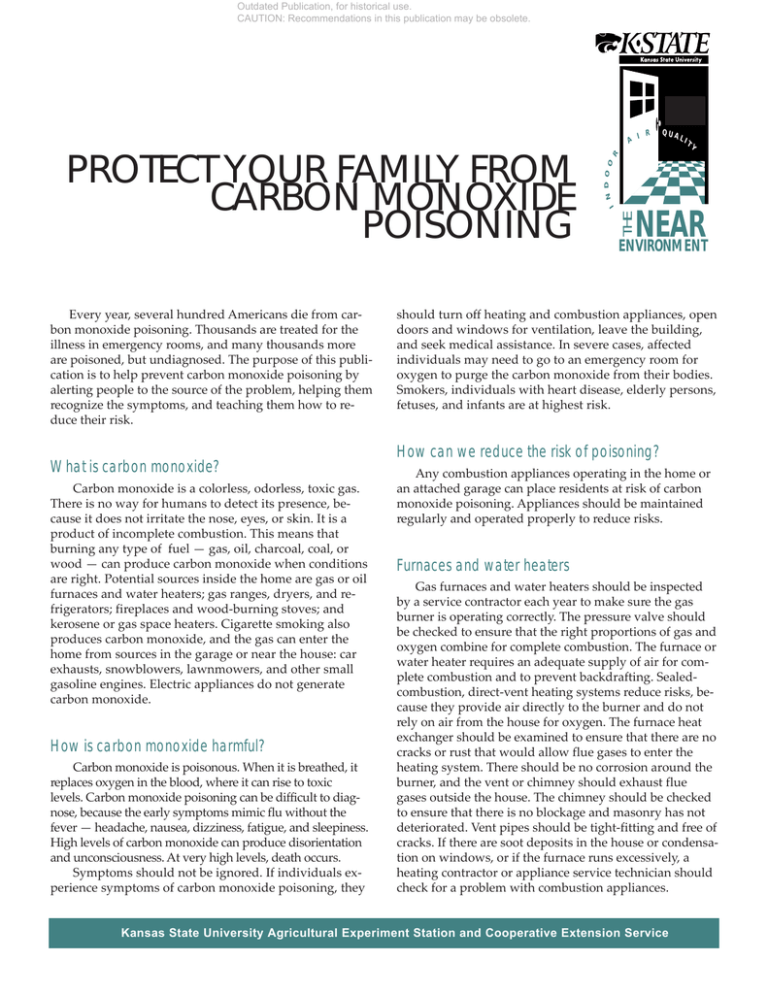
Outdated Publication, for historical use.
CAUTION: Recommendations in this publication may be obsolete.
1
INDOORAIR QUALITY
I R
Every year, several hundred Americans die from carbon monoxide poisoning. Thousands are treated for the
illness in emergency rooms, and many thousands more
are poisoned, but undiagnosed. The purpose of this publication is to help prevent carbon monoxide poisoning by
alerting people to the source of the problem, helping them
recognize the symptoms, and teaching them how to reduce their risk.
What is carbon monoxide?
Carbon monoxide is a colorless, odorless, toxic gas.
There is no way for humans to detect its presence, because it does not irritate the nose, eyes, or skin. It is a
product of incomplete combustion. This means that
burning any type of fuel — gas, oil, charcoal, coal, or
wood — can produce carbon monoxide when conditions
are right. Potential sources inside the home are gas or oil
furnaces and water heaters; gas ranges, dryers, and refrigerators; fireplaces and wood-burning stoves; and
kerosene or gas space heaters. Cigarette smoking also
produces carbon monoxide, and the gas can enter the
home from sources in the garage or near the house: car
exhausts, snowblowers, lawnmowers, and other small
gasoline engines. Electric appliances do not generate
carbon monoxide.
How is carbon monoxide harmful?
Carbon monoxide is poisonous. When it is breathed, it
replaces oxygen in the blood, where it can rise to toxic
levels. Carbon monoxide poisoning can be difficult to diagnose, because the early symptoms mimic flu without the
fever — headache, nausea, dizziness, fatigue, and sleepiness.
High levels of carbon monoxide can produce disorientation
and unconsciousness. At very high levels, death occurs.
Symptoms should not be ignored. If individuals experience symptoms of carbon monoxide poisoning, they
LI
TY
NEAR
THE
PROTECT YOUR FAMILY FROM
CARBON MONOXIDE
POISONING
QUA
D O O
I N
R
A
ENVIRONMENT
should turn off heating and combustion appliances, open
doors and windows for ventilation, leave the building,
and seek medical assistance. In severe cases, affected
individuals may need to go to an emergency room for
oxygen to purge the carbon monoxide from their bodies.
Smokers, individuals with heart disease, elderly persons,
fetuses, and infants are at highest risk.
How can we reduce the risk of poisoning?
Any combustion appliances operating in the home or
an attached garage can place residents at risk of carbon
monoxide poisoning. Appliances should be maintained
regularly and operated properly to reduce risks.
Furnaces and water heaters
Gas furnaces and water heaters should be inspected
by a service contractor each year to make sure the gas
burner is operating correctly. The pressure valve should
be checked to ensure that the right proportions of gas and
oxygen combine for complete combustion. The furnace or
water heater requires an adequate supply of air for complete combustion and to prevent backdrafting. Sealedcombustion, direct-vent heating systems reduce risks, because they provide air directly to the burner and do not
rely on air from the house for oxygen. The furnace heat
exchanger should be examined to ensure that there are no
cracks or rust that would allow flue gases to enter the
heating system. There should be no corrosion around the
burner, and the vent or chimney should exhaust flue
gases outside the house. The chimney should be checked
to ensure that there is no blockage and masonry has not
deteriorated. Vent pipes should be tight-fitting and free of
cracks. If there are soot deposits in the house or condensation on windows, or if the furnace runs excessively, a
heating contractor or appliance service technician should
check for a problem with combustion appliances.
Kansas State University Agricultural Experiment Station and Cooperative Extension Service
Outdated Publication, for historical use.
CAUTION: Recommendations in this publication may be obsolete.
2
THENEAR ENVIRONMENT
Gas ranges
Unlike gas water heaters and furnaces, gas ranges do
not have a vent or chimney to exhaust the combustion
products to the outside. It is a good practice to run the
range hood fan when using a gas range, either the stove
top or the oven, to exhaust the flue gases to the outside.
The exhaust fan should vent to the outside and not into
the attic or a crawlspace. If the flame in any of the burners
is not a blue color, an appliance service technician should
check and adjust the unit. Never use a gas range to heat
the house or kitchen.
Gas dryers
All dryers, whether gas or electric, should be vented to
the outside, not back into the house, attic, or crawl space.
Check to make sure that the hose leading to the outside
vent is not clogged with lint and that the vent flap on the
outside of the house opens when the dryer is running.
Vents can freeze shut during very cold weather, and exhaust fumes cannot escape.
Fireplaces and wood-burning stoves
Burning wood produces large amounts of carbon monoxide. Chimneys should be inspected and cleaned regularly so the combustion products exhaust to the outside.
Make sure the damper is open before starting a fire.
Unvented gas and kerosene space heaters
Non-electric space heaters not vented to the outside
are dangerous in enclosed spaces, because all combustion
products remain in the heated space. Such heaters should
not be used in enclosed spaces except in emergencies,
such as a power outage in the winter, and even then
should not be used to heat a space where people are sleeping. If heaters are used during emergencies, doors and
windows should be opened often to ventilate the area. The
heaters should not be used to heat garages or basements
unless there is plenty of ventilation.
Does carbon monoxide enter the house from an
attached garage?
Even with the garage door open, carbon monoxide
levels can reach toxic levels if cars or other gas engines
are allowed to run in an attached garage. The carbon
monoxide generated mixes with air and moves freely into
other spaces. An attached garage cannot be sealed well
enough to prevent carbon monoxide from entering the
house. If heating ducts or return air ducts run through the
garage, they can be pathways for carbon monoxide to
move into the house.
In the winter, starting a car produces large amounts of
carbon monoxide for a few minutes. After the car warms
up, less is produced. A car should never be left to run in
the garage. Lawnmowers, snowblowers, and other gasoline engines should not be run in a garage or other enclosed space. They produce significant amounts of carbon
monoxide, as do charcoal or gas grills.
Do carbon monoxide detectors work?
Carbon monoxide detectors have been on the market
for several years. As the technology improves, the reliability of detectors also improves. Detectors with the best reliability are those that meet a 1998 standard from Underwriters Laboratory (UL) as well as the standard from the
International Approval Service (IAS). When purchasing a
carbon monoxide detector, consumers should look for one
labeled UL 2034-98 (an indication that it meets the 1998
UL standard) or labeled IAS 6-96. Few companies currently market detectors that meet these standards.
Detectors contain an alarm that sounds when carbon
monoxide levels become dangerous. Low levels of carbon
monoxide can be present for a short time without triggering the alarm. The alarm should be taken seriously. Combustion appliances should be turned off and doors and
windows opened for ventilation. If residents experience
symptoms associated with poisoning, the house should
be vacated.
To check the house and identify the source of carbon
monoxide, call a heating contractor, an appliance service
technician, the fire department, or the gas company.
Outdated Publication, for historical use.
CAUTION: Recommendations in this publication may be obsolete.
INDOORAIR QUALITY
Ask for a technician who has experience in testing homes
for carbon monoxide and who can help identify the
source. Often, the house has been ventilated when the service technician arrives, and the conditions that caused the
alarm to sound no longer exist. An experienced technician
will know how to identify the source of the problem. If
the technician cannot find the problem, call another one.
Do not ignore the warning.
There are both 110-volt AC (plug-in and hard-wired)
detectors and battery-powered detectors. The AC-powered detectors have the advantage of not being dependant
on batteries being replaced regularly, whereas the batterypowered detectors have the advantage of being operational during a power outage. If you experience frequent
power outages (and especially if you use an unvented gas
or kerosene heater during these outages), a battery-operated
unit should be used. Some AC-powered detectors have a
battery backup that combines the advantages of each.
Where should a detector be installed?
The Consumer Product Safety Commission recommends placing at least one detector in the sleeping area of
every house. If just one detector is installed, it should be
located so it can be heard in every bedroom. If there are
bedrooms on several levels, install several detectors. Because carbon monoxide mixes with air, detectors can be
installed either high or low on a wall or on a ceiling. They
should not be installed in the kitchen, furnace room, garage, or in a very humid environment, such as the bathroom. Do not install near stored chemicals or near combustion appliances. Follow the manufacturer’s
instructions for installation. Carbon monoxide detectors
are required in recreational vehicles.
■
Call a service technician if you notice any problems with combustion appliances, if there are soot
deposits in the house or condensation on the windows, or if the furnace runs excessively.
■
Do not use unvented combustion appliances to
heat the house.
■
Do not use charcoal grills inside a house, garage,
recreational vehicle, or tent.
■
Do not run the car or other gas engines in
the garage.
■
Leave the house if you or other family members
experience symptoms of carbon monoxide poisoning. Seek medical assistance immediately.
■
Respond to a carbon monoxide detector alarm by
turning off combustion appliances, ventilating the
house, leaving the house if residents have symptoms of poisoning, and calling a qualified service
technician to find the problem.
Sources:
Iowa State University Cooperative Extension
Web site:
http://www.ae.iastate.edu/human housing.htm
American Industrial Hygiene Association Web site:
http://www.aiha.org/pr/carbon.html
Consumer Product Safety Commission, Carbon
Monoxide Fact Sheet #466.
U.S. Environmental Protection Agency, Protect Your
Family and Yourself from Carbon Monoxide Poisoning.
Summary
■
Install a carbon monoxide detector near sleeping
rooms in your house. Test it regularly to assure
that it is working properly.
■
Have a qualified service technician check all
combustion appliances in the home annually.
3
Written by Marilyn Bode, Extension Housing
Specialist, and reviewed by Nick Huser and Bruce
Snead, K-State extension specialists.
Outdated Publication, for historical use.
CAUTION: Recommendations in this publication may be obsolete.
4
THENEAR ENVIRONMENT
Brand names appearing in this publication are for product identification purposes only. No endorsement is intended,
nor is criticism implied of similar products not mentioned.
Publications from Kansas State University are available on the World Wide Web at: http://www.oznet.ksu.edu
Contents of this publication may be freely reproduced for educational purposes. All other rights reserved. In each case, credit Marilyn Bode,
“Protect Your Family From Carbon Monoxide Poisoning,” Kansas State University, June 1999.
Kansas State University Agricultural Experiment Station and Cooperative Extension Service
MF-2393
June 1999
It is the policy of Kansas State University Agricultural Experiment Station and Cooperative Extension Service that all persons shall have equal opportunity and
access to its educational programs, services, activities, and materials without regard to race, color, religion, national origin, sex, age or disability. Kansas State
University is an equal opportunity organization. Issued in furtherance of Cooperative Extension Work, Acts of May 8 and June 30, 1914, as amended. Kansas
State University, County Extension Councils, Extension Districts, and United States Department of Agriculture Cooperating, Marc A. Johnson, Director.
File code: Health (Human) – 2
NP

